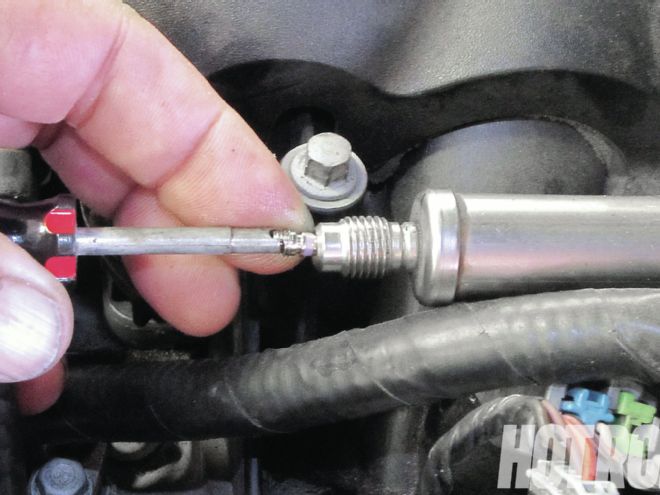
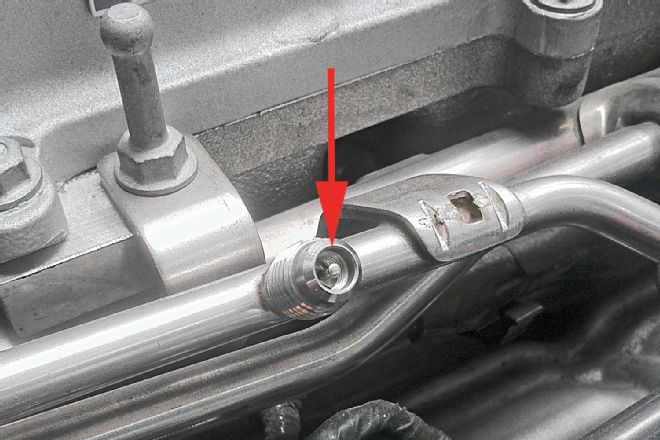 If the existing fuel pump and fuel lines have sufficient capacity, auxiliary fuel for the nitrous system can be supplied via the fuel-injection rail test-port. Inside the test-port is a Schrader valve similar to the valve used on a tire’s valve-stem (arrow).
If the existing fuel pump and fuel lines have sufficient capacity, auxiliary fuel for the nitrous system can be supplied via the fuel-injection rail test-port. Inside the test-port is a Schrader valve similar to the valve used on a tire’s valve-stem (arrow).
In a dry nitrous system, the extra fuel required to support the nitrous shot is introduced through the existing electronic fuel injectors. No fuel flows through the intake manifold plenum or runners (that’s why it’s called a “dry” system). In a dry system, fuel flow can be increased by raising the fuel-injection system pressure or by reprogramming the ECU to increase the fuel injectors’ dwell-time (the period the fuel injectors remain open). The auxiliary nozzles on this type of system spray nitrous only. Usually the nitrous oxide nozzles spray through the mass airflow (MAF) sensor, which assumes it’s seeing colder, denser air, and sends a signal to the ECU to supply more fuel.
In a wet single-point system, fuel and nitrous are introduced together via a combined nitrous and fuel fogger-style nozzle. Usually on a fuel-injected application, the nozzles are fitted to a plate that mounts between the throttle-body and intake manifold, or in a modified inlet duct leading to the throttle-body.
In a wet nitrous system (aka a direct-port nitrous system), nitrous and fuel are introduced directly into each inlet port near the cylinder-head end of the manifold’s runner. There can be one combo nitrous and fuel nozzle in each runner or a separate nitrous and fuel nozzle for each runner.
A dry system is generally recommended for entry-level applications on a stock- or near-stock, normally aspirated engine up to about the 150hp-shot level. The problem is that relying on the MAF to tell the computer more fuel is needed when you hit the nitrous button is relatively inexact and is subject to system lag as the amount of nitrous injected into the engine increases. As power levels go up, sophisticated ECU reprogramming is required, and even with new tuning it is usually difficult to achieve consistent power gains at higher nitrous power levels.
Wet systems meter nitrous and fuel through jets with different orifice sizes. For the average hot rodder, this makes it easier to fine-tune the proper air/fuel ratio. Sophisticated computer reprogramming skills are not critical. However, on a single-port wet system, there’s a definite limit to what can be accomplished when installing such a system on factory-style EFI intake manifolds that are usually designed to flow air only, with smaller orifices and relatively sharp edges and turns compared to, for example, an old-school carburetor-style manifold that was designed to flow both air and fuel. That’s because fuel, being heavier than air or nitrous, has a hard time when in motion; it doesn’t like to turn corners due to its greater inertia. The fuel may separate from the air, and the nitrous from the fuel. This can cause backfiring or a lean condition in one or more cylinders.
A wet direct-port system solves the fuel-distribution problem, but it is both more expensive and harder to plumb and install, requiring intake manifold modifications to accommodate the added nozzles. Using separate nozzles for each port allows adjusting each cylinder’s nitrous fuel ratios individually without affecting the fuel ratio in the other ports. At the top of the food chain, multistage wet direct-port systems have the potential to make thousands of horsepower on all-out race cars.
On an inline engine configuration such as the Quad 4, achieving optimum fuel ratios in each cylinder is arguably more critical than on a V8, for several reasons: First, gaining 200 hp with just four (as opposed to eight) cylinders via a nitrous shot means the supply system, nozzles, and the cylinders themselves need to work harder, because each cylinder must make proportionally more horsepower per cubic inch than on an equivalent-size V8 engine that spreads its total displacement among four extra cylinders. Second, assuming a centrally located throttle-body and plenum chamber, on an inline engine the end cylinders may tend to run leaner with a typical calibration scheme because the air has further to travel.
Nitrous Supply’s Mike Thermos says this is why 200 hp—give or take— is really the crossover point where you need to seriously consider a direct-port wet nitrous system for a four-cylinder inline application. You may scrape by with a single-port wet system, but—let’s face it—you nitrous guys always end up wanting more. Be realistic and design a system with built-in reserve that can accommodate that inevitable thirst for even more power.
That reserve capacity all starts with the fuel pump. Is your 255-lph fuel pump up to the job? How much power can it support in the real world? One liter equals 0.264172 gallons. One gallon of gasoline weighs approximately 6.25 pounds at 72 degrees F. A good rule of thumb is that a typical engine requires about 0.5 pound of gasoline to make 1 hp for 1 hour (otherwise known as brake specific fuel consumption, or BSFC). Putting this all together, the math looks like this:
[(0.264172 Gal/1L) x (255L/Hr) x (6.25 lbs/1 Gal) x (1 hp/0.5 lb/hr)] = 842.04825 hp
Theoretically, your pump should support 842 hp at its rated operating pressure and voltage. But that’s with no safety margin. Remember, pump ratings are usually established under “free-flow” conditions, without considering the restrictions imposed by the fuel lines, bends in the line, and fitting orifices. The higher the fuel pressure, the lower the pump’s output (although higher pressure may compensate to some extent for undersize fuel injectors). Any voltage drop in the system also reduces pump output.
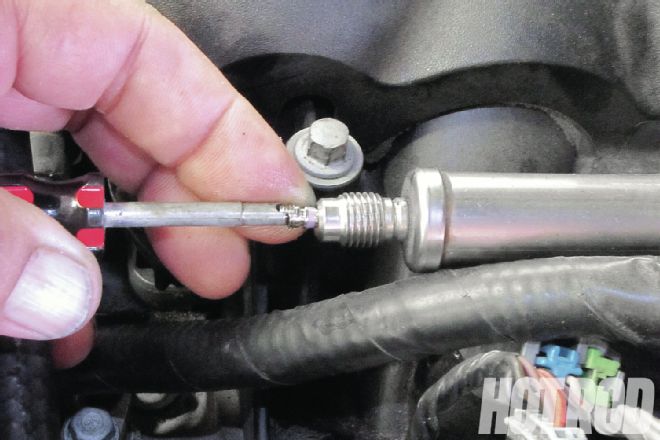 The same tool normally used to tighten or remove the valve from a tire valvestem will work for removing the valve from the rail’s test-port.
The same tool normally used to tighten or remove the valve from a tire valvestem will work for removing the valve from the rail’s test-port.
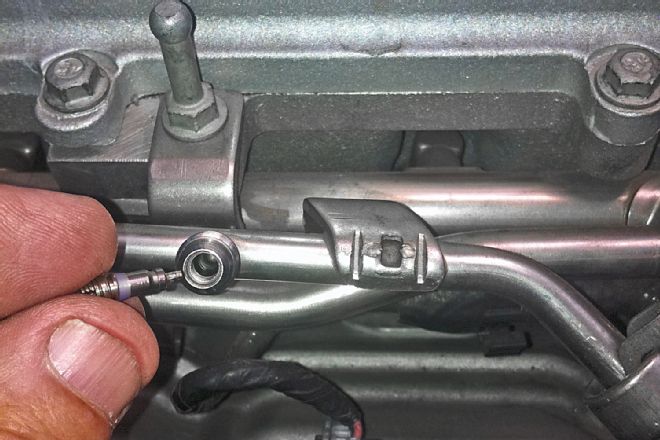 After unscrewing the valve, set it aside—it will no longer be used. The only downside is that there will no longer be a quick-disconnect, easy-access fuel-pressure test-point.
After unscrewing the valve, set it aside—it will no longer be used. The only downside is that there will no longer be a quick-disconnect, easy-access fuel-pressure test-point.
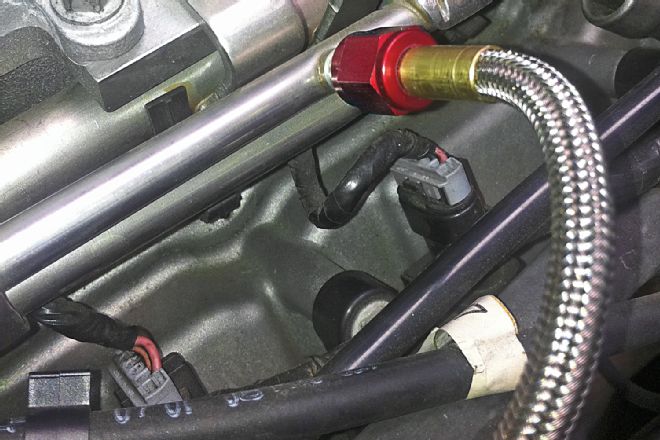 Once the valve is removed, in nearly all cases a standard AN-style swivel nut screws right onto the test-port’s external threads and seals against its cone. Rarely, an O-ring–type adapter fitting may be needed. Teflon-core hose and a good inline filter are now recommended even on the fuel-side of the system to prevent clogging of the small-orifice fuel metering jets.
Once the valve is removed, in nearly all cases a standard AN-style swivel nut screws right onto the test-port’s external threads and seals against its cone. Rarely, an O-ring–type adapter fitting may be needed. Teflon-core hose and a good inline filter are now recommended even on the fuel-side of the system to prevent clogging of the small-orifice fuel metering jets.
Having to contend with all these variables, personally I believe in overkill when it comes to the fuel supply. A good practice is to underestimate published flow numbers by 50 percent (which as a byproduct also allows headroom for future growth). This (admittedly gross) rule of thumb reduces the pump‘s real-world fuel-flow capacity to around 420 hp. Another way of looking at it is, whatever you think is needed in terms of pump capacity, double it!
How much power will your engine make without the bottle? If the engine’s normally aspirated power level is much more than 200 hp, the “50 percent derating” rule may require running either a larger pump or even an auxiliary fuel pump and separate nitrous fuel-supply line to support a 200hp nitrous shot. At that point, tapping into the stock fuel supply system is moot.
However, assuming the existing fuel pump and fuel line setup will support the power level on the bottle without the need for an auxiliary pump and lines, you can easily plumb the fuel-side by running a line to the fuel-injection rail’s test-port (see photos). As for initial wet direct-port system calibration, on a four-cylinder engine with a 200hp nitrous shot, Thermos recommends starting with No. 24 nitrous jets and No. 18 fuel jets in its fogger-style nozzles. This assumes a 6-psi baseline nitrous fuel pressure regulated by a inline step-down regulator installed in the nitrous fuel line. Supplying the nitrous-side fuel at high port fuel-injection system pressure would mandate tiny, extremely clog-prone, nitrous fuel-side jet orifices.
Ask Marlan A Tech Question: [email protected]